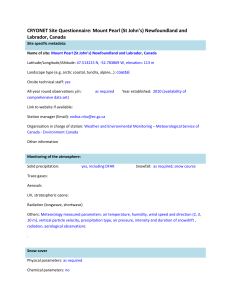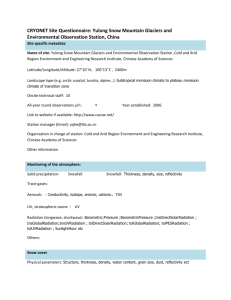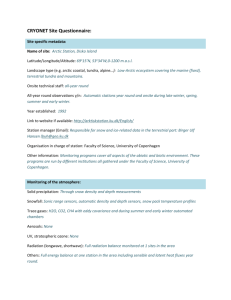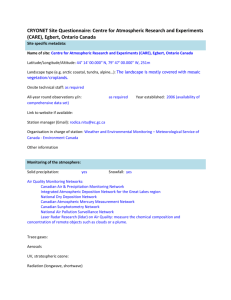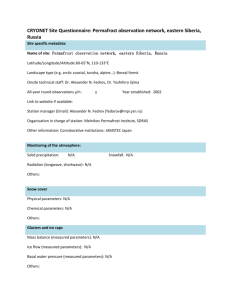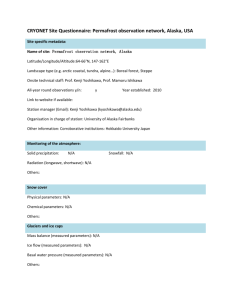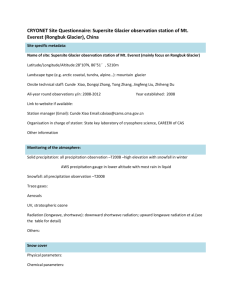Dome C
advertisement
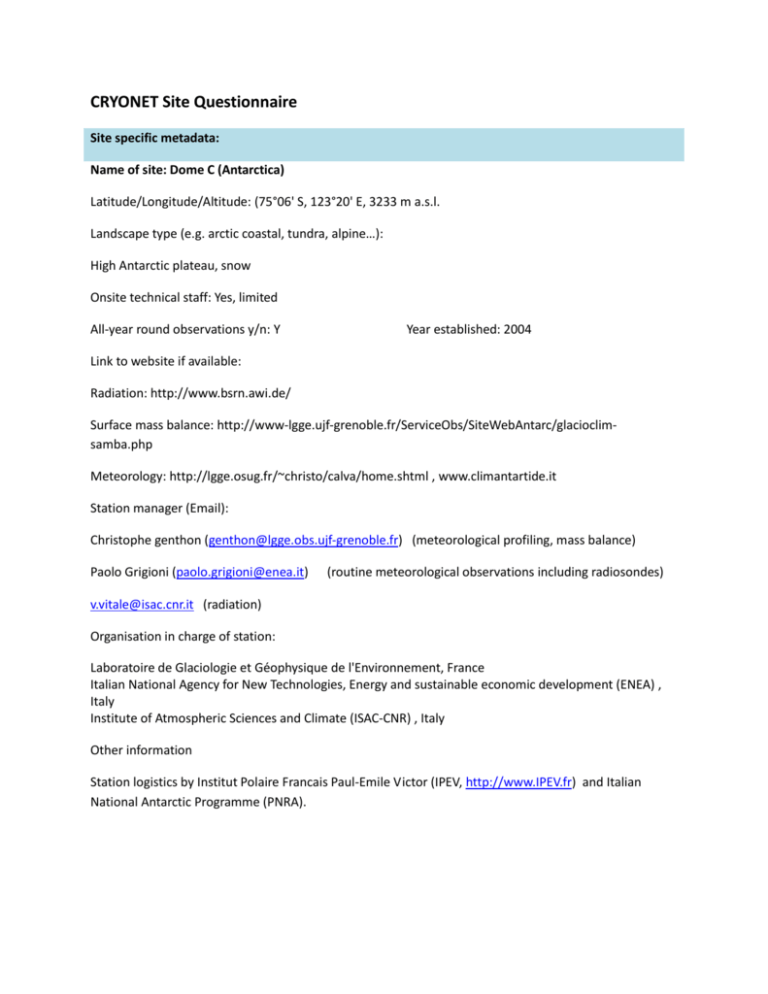
CRYONET Site Questionnaire Site specific metadata: Name of site: Dome C (Antarctica) Latitude/Longitude/Altitude: (75°06' S, 123°20' E, 3233 m a.s.l. Landscape type (e.g. arctic coastal, tundra, alpine…): High Antarctic plateau, snow Onsite technical staff: Yes, limited All-year round observations y/n: Y Year established: 2004 Link to website if available: Radiation: http://www.bsrn.awi.de/ Surface mass balance: http://www-lgge.ujf-grenoble.fr/ServiceObs/SiteWebAntarc/glacioclimsamba.php Meteorology: http://lgge.osug.fr/~christo/calva/home.shtml , www.climantartide.it Station manager (Email): Christophe genthon (genthon@lgge.obs.ujf-grenoble.fr) (meteorological profiling, mass balance) Paolo Grigioni (paolo.grigioni@enea.it) (routine meteorological observations including radiosondes) v.vitale@isac.cnr.it (radiation) Organisation in charge of station: Laboratoire de Glaciologie et Géophysique de l'Environnement, France Italian National Agency for New Technologies, Energy and sustainable economic development (ENEA) , Italy Institute of Atmospheric Sciences and Climate (ISAC-CNR) , Italy Other information Station logistics by Institut Polaire Francais Paul-Emile Victor (IPEV, http://www.IPEV.fr) and Italian National Antarctic Programme (PNRA). Monitoring of the atmosphere: Solid precipitation: Automatic recording of precipitating ice images; automatic sizing and shape characterization of falling crystals (http://lidarmax.altervista.org/englidar/_Antarctic%20Precipitation.php) (Massimo Del Guasta IFACCNR - m.delguasta@ifac.cnr.it ) Snowfall: Trace gases: ozone surface concentration; planned yet installation of DOAS spectrometer Aerosols: On the vertical column - AOT with sun-photometers. at surface - size distribution, absorption coefficient, and chemical characterization (IC) of PM10 (1 and 3 days resolution), size-segregated particulate (>10, 10-2.5, 2.5-1.0, < 1.0 um – 3 day resolution) and EC-OC (15 days resolution). UV, stratospheric ozone: through band radiometers (UV-RAD and SAOZ). In the near-future with DOAS spectrometer also. Radiation (longwave, shortwave): YES, Baseline Surface Radiation Network downwelling and upwelling fluxes Others: Lidar measurements to investigate cloud microphysics, structure, and diamond dust precipitation. Aerosols below the detection limit Radiation (longwave, shortwave): Others: Daily radiosonde since March 2005, surface automatic weather, tower meteorological profiling, see details in Icesheet section Snow cover Physical parameters: Chemical parameters: Others: Glaciers and ice caps Mass balance (measured parameters): Ice flow (measured parameters): Basal water pressure (measured parameters): Others: Sea ice Mass balance (measured parameters): Meteorology: radiation, air temperature, humidity, wind speed and direction, air pressure (measured parameters): Snow on ice (measured parameters): Ice chemistry (measured parameters): Others: Permafrost Borehole measurements (measured parameters): Meteorology: radiation, air temperature, humidity, wind speed and direction, air pressure (measured parameters): Snow on ground (measured parameters): Active layer thickness (measured parameters): GST: Others: Ice sheet Mass balance (measured parameters): Annual accumulation on 3 stakes networks, annual, + ~monthly in summer at one network Meteorology: radiation, air temperature, humidity, wind speed and direction, air pressure (measured parameters): Radiation: Baseline Surface Radiation Network site (broadband shortwave and longwave downwelling fluxes and shortwave components since 2006, broadband upwelling fluxes measured at 3 m and 30 m height, since 2007) Temperature, humidity, wind speed and direction, pressure at several surface automatic weather stations Temperature, humidity, wind speed and direction at 6 levels on a 45-m tower Snow on ice (measured parameters): Snow Temperature measured at different depth in the 0-10 m range- continuously Snow density measured in the first meter (once per week) Snow deposition (twice per week) Snow grains size (at surface level) - (twice per week) Morphological characterization of ice and snow crystals. Ion composition (inorganic anions and cations, some selected organic anions) of superficial snow. Sampling of one (winter) or two (summer) samples per day all year round. broadband albedo (since 2007) Automatic recording of hemispheric surface images from 3 m height (since 2011 - every 10 minutes) Ice chemistry (measured parameters): Ion Chromatographic measurements on firn and ice core drilled around DC Others: Other measurements (hydrological, ecological, oceanographic, etc) Hydrology (measured parameters): Ecology (measured parameters) Oceanography (measured parameters): Other thematic linkages: Linkages to satellite data (describe validation programs, applications of satellite data, etc.) High density of overpass for polar orbiting satellites, very homogeneous surface and lack of significant topography make Concordia on the Dome C a very favourable site for calibration and validation and other research related to satellite data. Additionally, the Concordia Station, during the austral spring, is located inside the region where ozone depletion (ozone hole) takes place and therefore ground measurements performed in this site will be useful to validate the results of space sensors devoted to monitor the atmospheric composition in the stratosphere. The synergy between Concordia (75°S) and the coastal Italian and French stations of Mario Zucchelli (74°S) and Dumont D’Urville (66°S) can increase the potential of cal/val activities for missions devoted to investigate atmospheric composition and processes, especially through the comparison of two different regimes/conditions with the same observing geometry in the case of Concordia and Mario Zucchelli stations. In recent years several projects have been carried out in support of the calibration and validation activities of satellite missions using the Dome C area as reference target. Several of them use satellite data collected by SPOT (Six et al. 2004), AIRS (Walden et al. 2006) , MODIS (Wenny and Xiong 2008), AMSU (Mo 2011), IASI (Rabier et al. 2010) and confirm the potential of the site for this specific purpose. In addition to these projects, which use satellite data only, a few additional pilot projects dealt with field measurements at Concordia. Among them is that conducted by the University of Washington in cooperation with LGGE which includes the measurements of the bidirectional reflectance distribution function (BRDF) in the wavelengths range 350–2400 nm, the experiment DOMEX conducted by IFAC-CNR in cooperation with ESA in support to the SMOS mission which includes an L-band microwave radiometer (Macelloni et al. 2005) and the validation of thermal infrared sounder and imager (Brun et al. 2011). Future activities are planned as for example the DOMEX-3 follow-on experiment (which will be supported by ESA) and an experiment conducted by a team of European research institutes to produce a comprehensive characterization of the bi-directional properties of snow/ice spectral reflectance using a gonio-hyperspectral radiometer system. Furthermore other developments are expected using the potentiality of current ground based year-round measurements (radiometric, active passive remote sensing, etc.) and their planned extension. Participation in international monitoring programmes such as GAW, GTN-G, GTN-P, …. Baseline Surface Radiation Network
